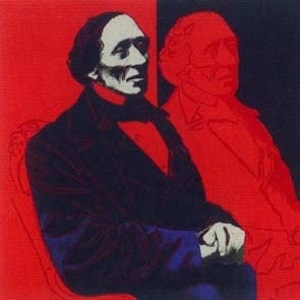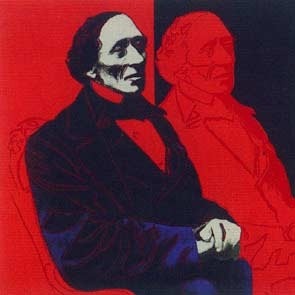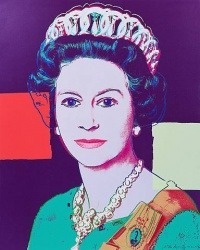NOTHING OF WARHOL OR STYLISATION (STERILISATION) OF CHAOS 0
Milda Kiaušaitė
www.kamane.lt , 2010 11 15
A.Warhol
A.Warhol. "H.C.Andersen"
A.Warhol. "Queen Elizabeth II"
In brief: The exhibition of silk prints “The Queen, Warhol and Me” initiated by the Danish Embassy in Lithuania and partners was opened at Kaunas Photography Gallery (Rotušės Sq. 1/ Vilniaus Str. 2) on the 16th of November, 2010. It will be open until the 30th of November.
The exhibition, which has already visited Vilnius, comprises of two series of posters created by the famous artist Andy Warhol in the late period: “The Reigning Queens” series (portraits of Queen Beatrix of the Netherlands, Queen Elizabeth II of the United Kingdom, Queen Ntombi Twala of Swaziland, and Queen Margrethe II of Denmark) and “The H. C. Andersen” series (the portrait of the writer and three prints derived from Andersen’s own cut-out paper silhouettes: “Women Around a Tree”, “Pjerrot with Swans and Buildings”, and “Miller with Dancing Girl and the Sandman”). The posters were inspired and commissioned to A.Warhol by the famous Danish art photographer Evan Frederiksen.
The author of the article was interested by the title of the exhibition (“The Queen, Warhol and Me”) and, therefore, tried to discover the tiny threads connecting everything. There have been many events relating these three items; still, nothing more tangible than the treble of a butterfly’s wings and the Theory of Chaos may be detected. When the movement of pop art was born in Britain and America in about 1950, Lithuania was crushed in the fist of Soviets and artists were constrained by the social realism. The only Lithuanian (Polish) queen Barbora Radvilaitė is long dead…
Andy Warhol is known to the general public for drawings on soup cans and cola bottles. Of course, the platinum wig of Andy, the picture of Marilyn Monroe could be known to people; they could have heard about The Factory, the workshop where many creative projects initiated by the artist were implemented. Still, the artist who has sold his most expensive painting for USD 100 million, who propagated and adored pop culture all his life is worth to be known.
The successful designer, the most famous artist of pop art movement, creator of films pictured things which seemed beautiful to him in his works: things which one sees every day and never takes a thought about them. When asked about Campbell’s soup cans in one interview, A. Warhol answered, “I wanted to draw nothing. I searched for something that would contain the essence of nothing, that’s it.” The artist did not like to comment his works.
The artist who dreamed of becoming a machine wanted to deny the cult of authenticity of a work and to make the technique of creation as simple and mechanical as possible so that an image could be copied by any friend.
The head of Kaunas Photography Gallery G. Česonis motivates the series chosen for the exhibition at the gallery by the fact that “the relation with photography is present in all works of the artist, no matter what technique has been used. Photography is like a notebook, part of research, method of thinking, technical means or simply a way of picturing ideas and thoughts of an artist.”
The very fact that A.Warhol has transferred not only packages and labels of famous companies but also many photographs on canvas reflects the ground of art practice of today: interpretation and recreation. Picturing the packages of mass production, celebrities, politicians and catastrophes, the artist revealed the diversity and poverty of pop culture vividly, presenting the stylisation of real life.
The works of A.Warhol presented in Kaunas are barely known; still, they correspond to the aim of the artist: to celebrate the popular culture, no matter whether we are speaking about the queen, member of the parliament, singer, actress or a star taken to the sky due to some scandal.
Painting the four queens, Andy treats them as famous film actresses or singers; interpreting the icon-like and aristocratic images, he behaves in a more than familiar manner. For instance, the portrait of Elizabeth II created in 1980 turns the queen into a clubber of Manhattan. Using flat, stylised portraits created in unexpected colours (the portrait of Marilyn Monroe appears in the eyes at once), A. Warhol succeeded to render the image of queens formed by the popular culture and to emphasise the narrowing understanding, the vanishing epithets, the contracting conscience of a consumer.
Meanwhile, the H. C. Andersen series reflects the artist’s inclination to traditional painting. Even though the portrait of the writer is iconised, the closer and more personal relation with the pictured person is betrayed by the soft and neatly chosen colours; symmetrical composition grants calmness to the works. To tell the truth, the portrait of H.C.Andersen is the most impressive in the entire exposition. Perhaps it is due to the face that reminds of a mask, the joint hands and the spirit of the writer flying nearby, the internal essence, the screaming colours that contrast with the internal concentration and the acted peace.



